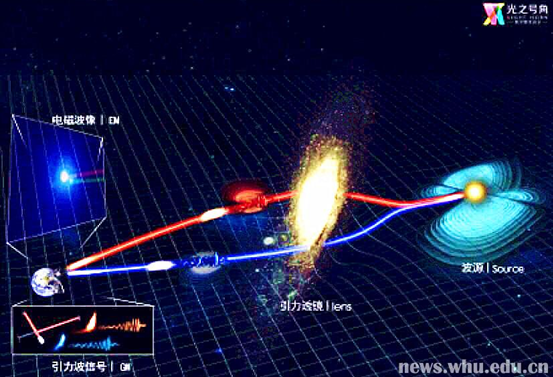Prof. Zhu Zonghong and his team in the School of Physics and Technology, Wuhan University, made another breakthrough in the studies of gravitational wave. In this research, Hubble constant is precisely measured with the lensed gravitational wave and electromagnetic counterparts system. This finding was published in Nature Communications and made headlines in Science and Technology Daily on October, 30th.
This paper titled Precision cosmology from future lensed gravitational wave and electromagnetic signals is accomplished under the main contribution of Liao Kai, Fan Xilong and Ding Xuheng .
Last year, Laser Interferometer Gravitational-Wave Observatory (LIGO) in USA released the firstly detected binary black hole gravitational wave signal, namely GW150914. This detection opened a new window to human exploration of the universe. On October 3rd, Royal Swedish Academy of Sciences announced the 2017 Nobel Prize in physics to be awarded to Rainer Weiss, Kip Stephen Thorne and Barry Clark Barish, the three main founders of LIGO. Thirteen days later, LIGO declared that it detected GW170817, a gravitational wave signal generated by the collision of two neutron stars, as the astronomical telescopes of various wavebands had successively detected the electromagnetic signals. Consequently, gravitational wave and multi-messenger astronomy finally became reality.
The traditional method of studying cosmology with gravitational waves relies on gravitational-wave standard siren to measure the luminosity distance. Such method requires precise waveform information; however, the waveform information acquired usually has high data errors. The team of Prof. Zhu Zonghong states that observation of lensed gravitational waves and electromagnetic signals system can greatly improve the measurement accuracy of cosmological parameters, especially the Hubble constant. In such system, firstly, the measurement of gravitational waves provides extremely precise multi-image time-delay information. Meanwhile, Fermat potential is accurately reconstructed through the observation of complete host galaxy arcs. Both aspects outperform those of the traditional quasar lens system.
The team proves that only ten systems of this pattern can control the precision of Hubble constant within 0.68%. Independent high-precise measurement can help resolve the contradictions between current results of microwave background radiation and supernova, or it can unveil a new physics. Previously, the team put forward that such system could be used to measure the velocity of gravitational waves, which was published in Physical Review Letters.

(Rewritten by Zheng Lingling, Edited by Shen Yuxi, Hu Sijia )


